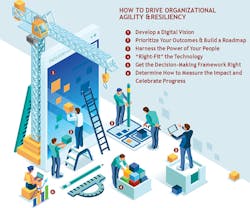Contributed by Steve Boughton
Industry 4.0 is a decade in the making yet is still seemingly out of reach for many manufacturing organizations. Why are so many middle-market companies still failing to take advantage of innovations that are seen by others as entry-level? Before we can answer these questions, we must agree on defining Industry 4.0 or risk adding to the confusion. And this is half of the problem – Industry
4.0 can be whatever you want it to be, driven by your perceived needs as a manufacturer or as a technology provider with the latest enterprise solution.
For our purposes, we will define Industry 4.0 in practical terms – as a technology toolbox. And like any toolbox, it is filled with everyday tools (like a hammer) and highly specialized. Industry 4.0 toolbox contains IIOT sensors, Artificial Intelligence, Augmented Reality, Big Data, Advanced Robotics, AGVs, wearables, additive manufacturing, and much more. However, no matter the tool, we can likely agree the common theme is a desire to digitize data, harness it in real-time, and use it to drive improvements in agility and resiliency that could not otherwise be achieved. An “augmentation of the possible,” if you will.
In IndustryWeek’s most recent survey, only 40% of large companies have a long-term Industry 4.0 strategic roadmap in place. And that figure is only 18% for firms with revenues of less than $1b. So, it is little wonder technology adoption rates are so low – with a lack of enterprise direction, manufacturing professionals are left to figure it out for themselves, and then wrestle for funding and support with Finance and IT. Misconceptions thrive, and soon there is a belief digital advancement equates to an expensive, resource-heavy E2E transformation. In reality, some basic steps can be made inside the four walls of facilities, with a strong and rapid ROI.
FOCUSING ON THE FUNDAMENTALS
Before continuing a conversation about Industry 4.0, let us go right back to the “Why?” Are today’s manufacturing goals any different from those of prior decades? The fundamental objectives inside a plant remain the same:
- Health and safety of personnel
- Best possible quality
- Optimized throughput
- Engaged and productive employees
- Cost optimization
- Effective supply and demand planning
In simple terms, we want to see tangible, quantifiable, extraordinary business, and operational results that transition the organization into a top quartile performer. Every business improvement initiative is designed to impact positively on one or a combination of these fundamental goals. If Industry 4.0 gives us the technological toolbox to accelerate progress and improve business performance, why do so many companies lag in adoption?
THE HURDLES TO CHANGE
We have already touched on the biggest hurdle – a lack of strategic vision at the enterprise level. Industry 4.0 is “too big to handle,” leading to acceptance of the status quo. From the perspective of most senior leadership, the legacy equipment and systems do their job, and we can find sufficient marginal improvements around the edges without additional investment. This is likely not the feeling on the manufacturing floor. The result is many organizations do not seek to grasp the opportunity presented by individual elements of Industry 4.0. Taking a bite-sized approach and building a plan around the fundamentals could be a simple first step.
Financial investment is a key requirement, and technology gridlock can easily become a major hurdle. The fear of OT/IT cost and complexity is understandable. A perceived need to invest in new and expensive software systems and hardware infrastructure is common. Not to mention the seemingly high organizational costs of implementation – potential production disruption, resource drain, or the risk of getting stuck in the “pilot trap.” Poor definition of outcomes, initiatives are driven by IT, and not Operations are likely to fail.
Advancement does not necessarily require massive investments in new ERP and IT infrastructure. There will be a level of investment, but the keyword is an investment. Too many organizations fail to build the right business case for change and instead focus only on cost. Picking the right tool requires clarity and understanding of both qualitative and quantitative, measurable benefits. Simply installing sensors to capture real-time and accurate OEE measurements can have immediate and significant impacts with a highly desirable ROI measured in months, not years. Assuming the data is properly leveraged by operators and supervisors.
Of course, in too many instances, people are not ready for change. The fear of change is very real on the front line. The “lights out” factory does not need operators on the shop floor. But how real is that objective for most organizations today? People tend to jump first to the worst conclusions. Handled poorly, technology is seen as a path to unemployment. Handled well, technology can be welcomed as an enabler – yes, this will require a certain amount of upskilling (and therefore investment). Still, if better-trained operators can focus on value-added activities rather than reactive observation, it is a very different change conversation.
TURN THINKING ON ITS HEAD
We need to create a new and practical conversation, not one focused on the technology but one which considers broader business needs and the organization. If the coronavirus pandemic has taught us anything, we need to build organizational agility and resiliency. As a leader, ask yourself if you can drive these six steps inside your plant or organization.
1. Develop a Digital Vision
Make an honest assessment of where you are today and then look out 1, 3, and 5 years.
What do you want the organization to achieve?
What is the ecosystem you want to create?
If this vision is linked to the business strategy and objectives, not technology buzz, then it is more likely to get the C-Suite commitment. Five years is a long way out, and certainly, technology and business conditions will change, but you can plan with a higher degree of certainty in the nearer term. It is crucial Operations has a high degree of input to guide the need/solution conversation. It is important to frame this vision around the desired future state outcomes enabled by the technology toolbox.
2. Prioritize Your Outcomes & Build a Roadmap
Clarity of outcomes is essential, and these must be built out at the business level. Otherwise, you will fail to build the case for change. If Step One is “think big,” then Step Two is “focus small.”
Where are the areas you want to see an immediate impact?
Think smaller than the plant level – perhaps it is a single machine or production line. If you want to establish a “Smart Factory” in two years, build it in incremental steps that can be scaled quickly. Do not start with an “end to end” solution encompassing sales, customer service, and logistics that might stretch resources and risk failure.
3. Harness the Power of Your People
It is crucial to prioritize your people during any change management program. Make them an integral part of the process and show them how the right tools and information, in their hands, is a win-win. They will not be replaced by machines but instead will get better visibility of how to drive efficiency. Build the right culture that celebrates the full advantage of the technology. By making the data available in a user-friendly format, they get meaningful information and real-time actionable insights that will make them more efficient in their job. And do not forget to reward them for doing so.
4. “Right Fit” the Technology
Choose the right tools that align with your roadmap. This is how you avoid jumping on the latest trend, but instead focus on the right type and investment that will help achieve your immediate goals. Look for solutions that integrate with your legacy equipment and software systems. Beware of solution providers that can automate the factory floor but cannot give you the actionable functionality layer without costly new middleware and systems. The right business case and route to strong ROI rely on a measured, incremental approach.
5. Get the Decision-Making Framework Right
The right technology is crucial, and focusing on your people is a given, as discussed earlier. But to make the people-technology equation work, you need to ensure you have the right Decision-Making Framework in place (your Management Operating System).
What data do you want to collect, and how will that be interpreted to support the KPIs that drive the business? Are they the right measures, and do any KPIs compete across functional groups?
It is important to break down any silos of information and drive an automated, digital, and accurate picture. The technological solution alone cannot solve misunderstandings between the shop floor and the top floor. Worse, if the technology is installed on top of an inefficient Management Operating System, then you risk baking in and compounding problems.
6. Determine How to Measure the Impact and Celebrate Progress
Determining an accurate ROI can be a challenging task, which causes challenges in developing the business case. Collaboratively develop the mechanism to track activities clearly and evaluate measurable results. These results may be both quantitative and qualitative. An OEE improvement is easily observed with the right tools and should feed directly into an uplift in throughput. Machine monitoring should impact predictive maintenance modeling and a reduction in unplanned downtime. Both examples have defined financial benefits. However, the human impact is likely more difficult to measure. An improved sense of empowerment for an operator may turn into a better attitude, reduced turnover, and absenteeism. Whatever the impacts, they all need to be built into the business case and ROI equation – it is those successes will enable you to continue your digital journey.
CHANGE IS WITHIN REACH
Wherever you are on a technology journey, there is always another step to take. Perhaps you are in the starting blocks, ready to embrace change. Perhaps you are much further along and ready to make investments in advanced elements of Industry 4.0. Either way, the end goals are largely the same. Done well, an Industry 4.0 implementation that is right for you can generate a raft of data and insight to manage the business better and drive company competitiveness.
Change does not have to be a massive, radical, revolutionary transformation to realize these benefits. Any good change management program comes in bite-sized, manageable stages. Rushing your people, who are instinctively reluctant in the face of change, will likely backfire and lead to a failed initiative.
Today’s call to action is to take that first (or next) step – build a 90-day plan around a specific plant, line, or machine – and accelerate your digital journey.
ARE YOU READY TO TURN YOUR POTENTIAL INTO REALITY?
Feel free to call Steve Boughton at (+1) 919-434-3143, or visit auderepartners.com to get started.


